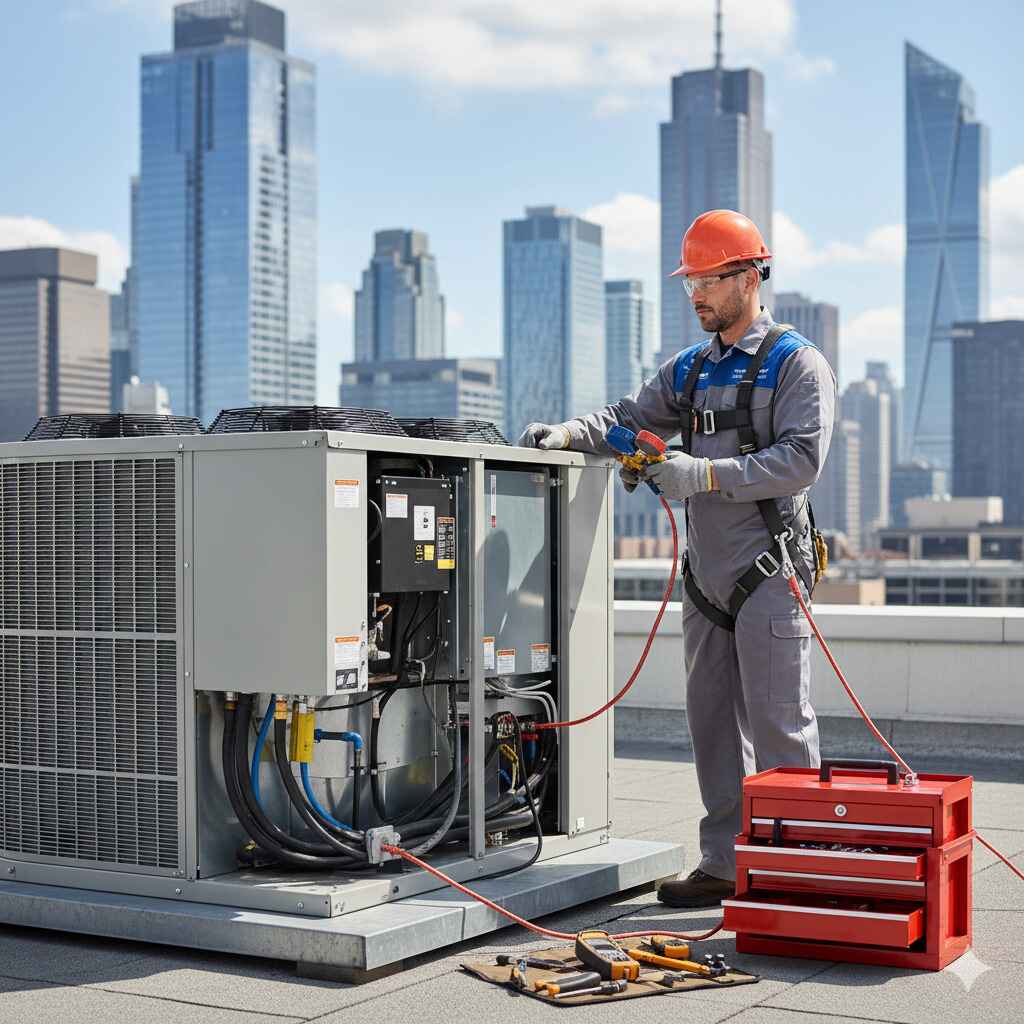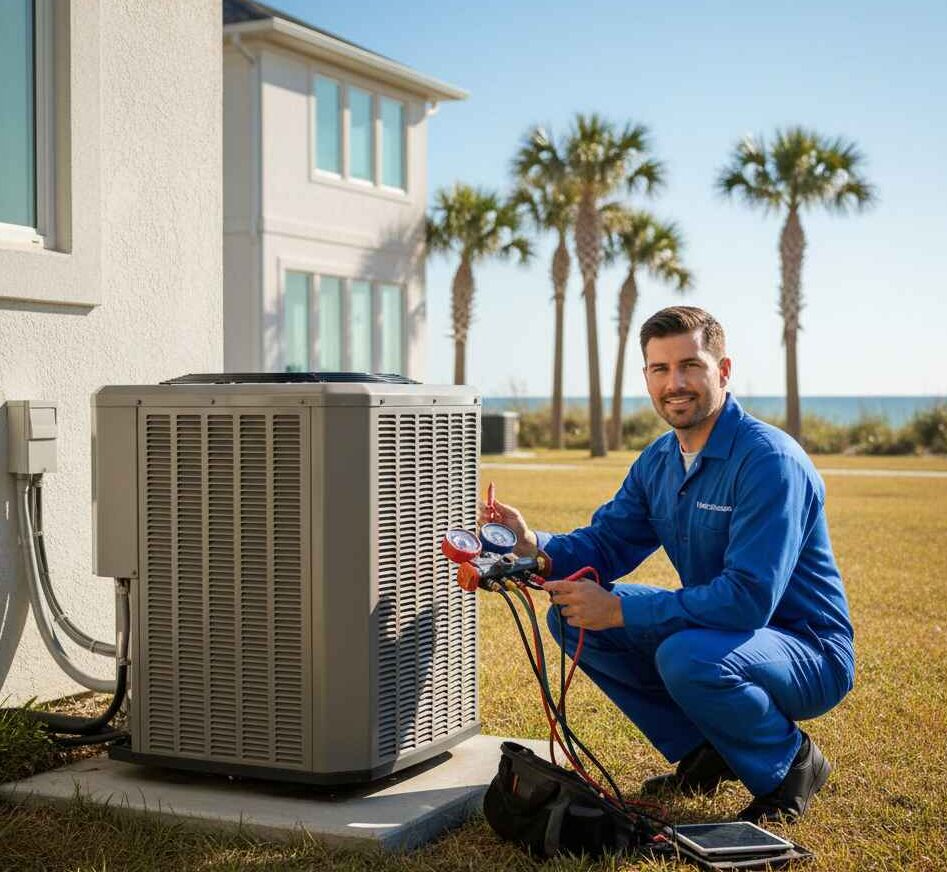1. Introduction
Commercial HVAC (Heating, Ventilation, and Air Conditioning) systems are critical infrastructure for offices, retail spaces, hospitals, schools, factories, data centers, and more. They maintain indoor comfort, control humidity, air quality, and ensure adequate ventilation. When something goes wrong, the consequences can include downtime of operations, discomfort for occupants, energy waste, or even safety issues.
This article focuses on commercial HVAC repair — diagnosing problems, executing effective repairs, preventing failures, budgeting, and choosing reliable contractors. Throughout, the keyword “commercial HVAC repair” will appear naturally, while maintaining value for readers such as facility managers, building owners, and operations teams.
By the end, you’ll have a complete, practical guide optimized for both search engines and real-world decision-making.
2. Why Commercial HVAC Repair Matters
2.1 Role of HVAC in Commercial Buildings
- Ensures occupant comfort (temperature, humidity)
- Maintains indoor air quality and ventilation
- Protects sensitive equipment (e.g., servers, labs)
- Ensures compliance with building codes and health regulations
- HVAC systems often account for 30–50% or more of total building energy use
When a system fails or degrades, costs escalate quickly — from higher utility bills and more frequent breakdowns to shortened equipment lifespan or complete failure during peak demand.
2.2 Impact of Poorly Maintained Systems
- Unplanned outages and downtime
- Discomfort and complaints from occupants
- Higher repair costs due to delayed action
- Increased energy waste and reduced efficiency
- Shorter equipment life
Repairing issues early helps restore performance, prevent future problems, and maintain efficiency.
3. Common Problems in Commercial HVAC Systems
Understanding these problems helps in prioritizing commercial HVAC repair and communicating effectively with technicians.
4. Signs You Need Commercial HVAC Repair
Watch for these warning signs:
- Sharp increase in energy bills
- Uneven temperatures across zones
- Strange noises (grinding, banging, squealing)
- Excess vibration or rattling
- Weak airflow or poor ventilation
- Frequent on/off cycling
- High humidity or condensation
- Unusual odors (burning, mold)
- Pressure irregularities in refrigerant circuits
- Repeated system alarms or error codes
If several of these appear, schedule a commercial HVAC repair assessment promptly.
5. The Commercial HVAC Repair Process: Step-by-Step
5.1 System Assessment & Diagnostics
- Review documentation, model numbers, wiring diagrams
- Check maintenance and repair history
- Interview operators or occupants about recent changes
- Inspect visually for leaks, wear, or damage
- Use tools like multimeters, airflow meters, and thermal imaging
5.2 Root Cause Analysis
- Identify the true source of failure
- Look for secondary issues (e.g., misalignment causing belt failure)
- Avoid “band-aid fixes” — resolve the cause, not just the symptom
5.3 Planning & Quotation
- Prepare a detailed estimate for parts, labor, and time
- Communicate impact and downtime clearly
5.4 Execution of Repair
- Follow all safety and isolation procedures
- Replace or repair faulty components
- Clean coils, replace filters, remove debris
- Calibrate sensors and controls
- Recharge refrigerant and verify for leaks
5.5 System Testing & Commissioning
- Test under full and partial loads
- Monitor pressures, airflow, electrical draw
- Validate performance and efficiency
5.6 Post-Repair Monitoring
- Track system via BMS or manual logging
- Watch for recurring issues or anomalies
- Fine-tune as needed
6. Preventive Maintenance vs. Reactive Repair
6.1 Benefits of Preventive Maintenance
- Fewer emergency repairs
- Predictable maintenance budgets
- Lower energy bills
- Longer equipment life
- Improved comfort
6.2 Typical Preventive Maintenance Tasks
- Quarterly or semiannual inspections
- Filter replacement
- Coil and duct cleaning
- Lubrication of moving parts
- Checking refrigerant pressures
- Electrical and control checks
- Calibration of sensors
6.3 Predictive / Condition-Based Maintenance
Advanced maintenance uses sensors, vibration analysis, and data trends to predict failures before they occur — a growing practice in large commercial facilities.
7. Cost Factors & Budgeting for Repair
7.1 Cost Components
- Labor and technician time
- Replacement parts
- Refrigerant costs
- Equipment rental (for rooftops)
- Diagnostic tools
- Indirect costs (downtime, lost productivity)
7.2 Cost Drivers
- Age and complexity of system
- Accessibility and location
- Regulatory compliance requirements
- Emergency vs scheduled repair
7.3 Budget Planning Tips
- Set a 10–20% contingency
- Use historical cost data
- Prioritize mission-critical systems
- Balance repair vs replacement
7.4 Return on Investment
A well-executed commercial HVAC repair improves energy efficiency, extends lifespan, and reduces overall operational costs.
8. Equipment Lifespan, Replacement, and When to Upgrade
8.1 Typical Life Expectancy
- Rooftop Units: 15–20 years
- Chillers: 15–25 years
- Boilers: 15–30 years
- Air Handlers: 15–20 years
- Condensers: 10–20 years
8.2 When to Replace vs Repair
- Frequent breakdowns of major components
- Parts no longer available
- Obsolete refrigerants
- High operating costs
- Better efficiency available from modern systems
8.3 Phased Upgrade Strategies
- Replace critical modules first
- Choose modular, scalable equipment
- Schedule upgrades during planned downtime
9. Choosing a Commercial HVAC Repair Contractor
9.1 Essential Contractor Qualities
- Licensed and insured
- Experience with large systems
- Proven references and reliability
- Transparent estimates and reports
- Availability for emergencies
9.2 Questions to Ask
- Do you have experience with similar systems?
- What diagnostic approach do you use?
- What are your warranties for labor and parts?
- How quickly can you respond in emergencies?
- Do you provide post-repair monitoring?
9.3 Contract Structures & SLAs
- Fixed-price or time-and-materials
- Performance-based guarantees
- Response-time agreements
- Preventive maintenance add-ons
A strong contractor acts as a partner — not just a service vendor.
10. Trends, Technologies & Future Directions
- Smart Controls & IoT Monitoring – Enables predictive maintenance and energy optimization.
- VRF & VAV Systems – Improve zoning and efficiency.
- New Refrigerants – Environmentally friendly and regulation-compliant options.
- Energy & Heat Recovery – Reuse waste heat for efficiency gains.
- AI & Machine Learning – Automated fault detection and optimization.
- Retrofit Solutions – Blend modern controls with existing infrastructure.
11. Case Studies
11.1 Office Tower Rooftop Unit Repair
- Situation: Uneven cooling on upper floors
- Diagnostics: Faulty compressor and refrigerant leak
- Repair: Replaced compressor, repaired leak, cleaned coils
- Result: Restored performance and reduced energy use by 8%
11.2 Retail Mall Air Handler Replacement
- Situation: Motor failure caused poor airflow
- Diagnostics: Bearing seizure due to misalignment
- Repair: Replaced motor and coupling, rebalanced fans
- Result: Improved efficiency, lower noise, and reduced complaints
12. Conclusion & Best Practices
12.1 Key Takeaways
- Early detection reduces repair costs and risk
- Preventive maintenance extends system life
- Choose experienced contractors
- Track system data post-repair
- Consider energy-efficient upgrades
12.2 Best Practices Checklist
- Document all system details and repair history
- Base repairs on diagnostics, not guesswork
- Repair root causes, not symptoms
- Keep critical spare parts on hand
- Monitor post-repair performance
- Partner with qualified, commercial HVAC professionals
By following these principles, your commercial HVAC repair strategy will ensure reliability, efficiency, and long-term value for your facility.


